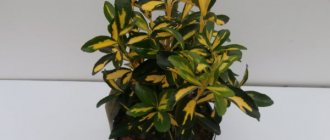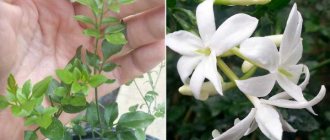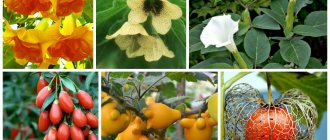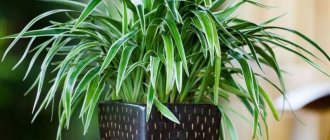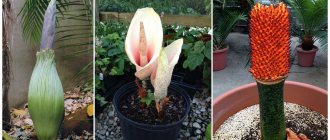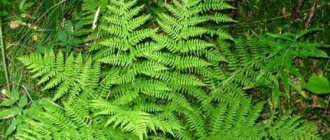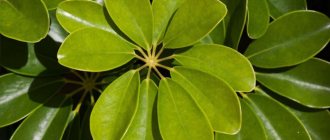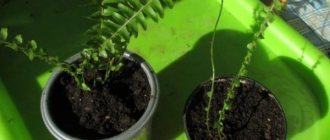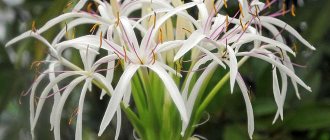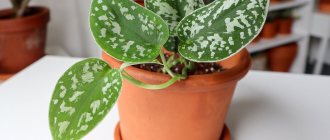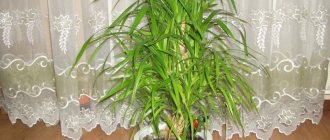Japanese euonymus (Euonymus japonica) is a fast-growing, evergreen shrub with leathery leaves. Depending on the variety, the leaf blades may be green, with a white or golden edge.
The flowers are small, white-green, collected in umbrella-shaped inflorescences, and have no decorative value. The flowering period occurs in mid-summer. Only mature plants can bloom, and then quite rarely. The fruits are four-lobed capsules. In indoor conditions, the height of the plant does not exceed 1 meter; in nature it can reach up to 6 meters or more. It has a high life expectancy, requiring annual pruning and periodic rejuvenation. Has a pronounced rest period.
| Growing quickly. In one season, the plant gains 10-20 cm in height. |
| It blooms very rarely and only on mature individuals. |
| The plant is easy to grow. |
| Perennial. Rejuvenate every 3-4 years. |
Caring for euonymus at home. Briefly
Euonymus at home requires the following care:
| Temperature | In summer +18-20°C, in winter +2-4°C. |
| Air humidity | Dense leaves easily withstand dry air. But when the heating is turned on, spraying may be required. |
| Lighting | Bright diffused light, without direct sunlight. |
| Watering | As the earthen coma dries out. Limited in winter. |
| Priming | A mixture of turf soil with humus with the addition of sand or perlite. |
| Feeding and fertilizer | During the period of intensive growth, once every 3-4 weeks, apply any complex fertilizer for decorative foliage plants. |
| Euonymus transplant | As you grow. Usually once a year. |
| Reproduction | Propagated by cuttings of green and semi-lignified shoots. For rooting, use light peat soil or clean sand. |
| Features of growing euonymus. | In winter, the plant needs to create a dormant period at low temperatures. To maintain its shape, it requires pruning in the spring. |
Care calendar
In spring, dry branches need to be removed. In April and May, Euonymus should be thoroughly fertilized using mineral fertilizer. Colloidal sulfur should be used as protection against pests in the spring.
In the summer, prevention of diseases and parasites is required. Insecticides must be used.
In autumn, it is advisable to clearly form the crown. the euonymus with mineral fertilizers in the fall.
In winter, mulching of the soil is necessary. For this you need sawdust, dry leaves and peat. Sheltering Euonymus for the winter should only be done for young plants (up to three years old). Adult specimens do not need this.
Caring for euonymus at home. Details
Like any other indoor plant, home euonymus requires some care. It can grow and bloom fully only if suitable conditions are created.
Euonymus flowering
The euonymus flower blooms extremely rarely at home .
To set flower buds, it needs a cold period of at least 2 months. You can create the necessary conditions on a frost-free loggia or veranda. The main thing is that the temperature does not rise above +10° and does not fall below +2°. The flowering of Japanese euonymus can also be stimulated by applying phosphorus-potassium fertilizers during the period of intensive growth. The plant cannot be fed when it is dormant.
Temperature
Euonymus at home requires maintaining moderate temperatures. The plant can react to a sharp drop by dropping leaves. It grows best at temperatures from +22 to +25°C.
In winter, Japanese euonymus should be placed on cool windows, away from heating radiators.
Spraying
When caring for euonymus at home, you should remember the need for spraying. It is especially important on hot summer days and during the heating season. For spraying, use settled water at room temperature. Otherwise, limescale will constantly form on the leaves.
It is useful to alternate spraying with a warm shower. It will not only clean the surface of the leaves from contamination, but also prevent the appearance of pests.
Lighting
For successful development, euonymus requires bright but diffuse lighting. It feels best on windows of eastern and western orientation. When placed on the south side it will have to be shaded. With a lack of lighting, the brightness of the color of the leaves is lost, they gradually begin to turn yellow and disappear.
Watering
During periods of intensive growth, euonymus requires abundant watering. At the same time, the soil substrate must not be allowed to become acidic, which can lead to the death of the plant.
It is optimal if the top layer of soil dries out a little between waterings. During cold wintering, watering is sharply limited. Watering is carried out only after the soil has completely dried.
Euonymus pot
Plastic and clay pots are suitable for growing euonymus. The main thing is that their size matches the size of the root system.
Transplanting from a small to a too large container is fraught with acidification of the soil and the death of the plant.
Soil for euonymus
Euonymus does not have any special requirements for soil. A sufficiently nutritious, loose substrate is suitable for its cultivation. For example, you can use soil made up of equal parts of humus, peat and sand with the addition of 2 parts of turf soil.
You can also purchase a ready-made industrial substrate for growing decorative leafy indoor plants.
Top dressing
Japanese euonymus is fed only during the period of intensive growth. To do this, use a complex organic-mineral fertilizer for decorative deciduous plants.
It should be diluted in full accordance with the attached instructions.
Fertilizing is applied once a week. Fertilizers are not used during the dormant period.
Euonymus transplant
Young euonymus plants require annual replanting.
Adult specimens are transshipped as needed. To do this, they are carefully shaken out of the old pot. Then carefully examine the root system. All old and rotten areas of roots are cut out using a sharp knife or scissors. When replanting, be sure to create a drainage layer at the bottom of the pot and check for holes to drain excess water.
Trimming
Euonymus pruning is carried out in early spring. Its goal is to obtain a thicker crown. To do this, remove the tops of elongated shoots. After this, 2-3 new shoots grow at the cut site. During pruning, the plant can also be given different shapes.
Kinds
Japanese euonymus grows in the form of a bush or tree. There are several related species:
- Pseudolaurus - height reaches one hundred and fifty centimeters, shoots are brown-green. Flowering occurs in June. The inflorescences are small yellow-green. It can grow in a shaded place with polluted air, but does not tolerate cold.
- Microphyllus - height up to fifty centimeters, yellow-green color. The leaves are small, the inflorescences are white.
- Dwarf - height up to one hundred centimeters. The shoots take root easily. The leaves are leathery, bright green, and have a bluish tint underneath. The inflorescences are red-brown, small.
- Fortune - is a close relative of the Japanese euonymus. The height of the creeping shrub is small, up to forty centimeters. Tolerates European winter well.
There are many varieties of Fortune's euonymus. They have different leaf colors. For example, bright green leaves have a yellow or white border. There is a species with yellow leaves, in the middle of which there is a green stripe. Some shrubs have green leaves in the warmer months, but turn bronze or purple in the fall.
Euonymus propagation
Euonymus can be propagated by both seed and vegetative methods.
Propagation of euonymus by cuttings
For cuttings, young, non-lignified shoots up to 5 cm long are cut from the plant. Before planting, it is recommended to treat them with a root formation stimulator. For example, you can use “Kornevin” or “Heteroauxin”.
For planting cuttings, a two-layer substrate is used. Its lower layer is made up of clean river sand, the upper layer is made of fertile, loose soil. The rooting process can last up to 1.5 months. After the plants begin to grow, they need to be pinched.
Growing euonymus from seeds
In summer, seed propagation can also be used. Since euonymus seeds are difficult to germinate before planting, they must be stratified at a temperature of 0 to +2°C for 2-3 months.
The readiness of the seeds for planting is determined by cracking of the skin. After this, they must be cleaned of any remaining covering peel and pickled in a weak solution of potassium permanganate. For sowing, loose, moisture-absorbing soil is used. As soon as the seedlings reach a height of 3-4 cm, they are dived into separate containers.
Application in landscape design
The plant is suitable for creating a hedge, as well as a border frame for plantings. If you put together a mix of different varieties of euonymus, you can create a wonderful picturesque composition to decorate your garden.
Varieties with uniform green foliage are often used as a background for bright flowers. Living garden figurines are also formed from such plants.
In landscape design, the most common varieties of Japanese euonymus are:
- pseudolaurel;
- microphyllus;
- dwarf.
Pseudolaurus in our country is grown as a houseplant or greenhouse plant. It does not tolerate low temperatures, but is very decorative.
Microphyllus is famous for its beautiful variegated leaves. This euonymus forms a low bush - a maximum of half a meter in height. But the foliage and beautiful flowers make it very elegant and elegant.
The dwarf Japanese euonymus grows up to a meter and is most often planted in open ground. The leaves of this shrub have a double color: bluish below and bright green above.
Diseases and pests
When growing euonymus, a number of problems may arise:
- Euonymus shoots stretch out. This problem occurs when there is insufficient lighting.
- The leaves are fading. With too much sunlight, the leaf blades become dull.
- The edges of the euonymus leaves are folded. Observed when placing the plant in the sun.
- The leaves turn yellow and fall off when the plant is flooded. Without taking appropriate measures in the future, it dies.
- Euonymus does not grow with excessive watering and constant stagnation of moisture.
The most common pests that attack euonymus are spider mites, scale insects, mealybugs and aphids. To combat them, it is recommended to use systemic insecticides.
Priming
The shrub feels good in the most ordinary soil. A mixture of turf with leaf soil, peat and sand is suitable. You can get by with garden soil or greenhouse soil.
For growing euonymus, acidic soil with lime and neutral soil are suitable. All of the listed species can be used for planting plants in them. It is important to carry out timely feeding.
Popular varieties of Japanese indoor euonymus with names and photos
In indoor floriculture, the following varieties of euonymus are most often used:
Latifolius Albomarginatus
Characterized by dark green leaf blades with a wide light border.
Luna
Greenish-yellow leaves with green edges.
Albomarginatus
Rich green leaves with a narrow white edge.
Mediopictus
The middle of the leaf blades is yellow, the edges are green.
Varieties
Selected varieties of Japanese euonymus are distinguished by high decorative properties.
- Extaz
The center of the narrow leaves is light yellow, the border is wide green. Height - 0.15 m.
- Aureus (Aureus)
The center of the elongated leaves is poisonous yellow, the border is narrow green. Height - 1.5 m.
- Ovatus Aureus (Ovatus Aureus)
In the center of the oval miniature leaves there is an emerald longitudinal stripe, the border is wide, bright yellow. Dwarf variety.
- Perolino
The leaf blades are mostly dark green, with chaotically scattered white strokes and veins. About 10% of the biomass can be completely whitened leaves - this is not a deviation, but a feature of the variety. Height - 1.5 m.
- Bravo
Unlike other varieties, this one does not have a clear color. Its leaf blades are chaotically scattered spots of different colors on a dark green background - yellow, beige, white, silver.
- Aureomarginatus (Aureomarginata)
The center of the almond-shaped leaves is green, the border is narrow (initially) golden. The peculiarity of the variety is that during the season the bright yellow edging of the leaf gradually grows and in the fall covers almost the entire plate. Height - 0.4 m.
- Latifolius Albomarginatus (Latifolius Albomarginatus)
The center of the leaf blades is green, the border is wide white.
- Albomarginatus (Albomarginatus)
Similar to Latifolius, but the border is narrow.
- Luna (Moon)
The center is olive, then it gradually turns into yellow, the border is wide green.
- Mediopictus (Mediopictus)
The center is golden, the border is green.
- Microphyllus (Microphyllus)
The center of the miniature leaves is green, the edge is golden.
- Microphyllus Aureovariegatus (Microphyllus Aureovariegatus)
Similar to Microphyllus, but the golden edge is much wider, so that the green center of the small leaves is almost invisible. Height - up to 0.8 m.
Landing
Let's consider the main points regarding the rooting of this plant.
Plot
We recommend planting the plant in a semi-shaded place. In such conditions, euonymus leaves turn out to be especially decorative - clean and bright, with a rich blue-green hue. In a sunny area, the foliage may dry out - especially if there is no regular and sufficient watering.
Temperature
Japanese euonymus does not like too hot temperatures. The optimal range for it is +25 degrees in summer and +18-12 in winter. In extreme heat, the plant may begin to shed its leaves.
The soil
Japanese euonymus does not have any special requirements for soil quality. The following soil mixture is optimal:
- sheet soil - 1 part;
- turf/garden soil - 2 parts;
- peat - 1 part;
- coarse sand - 1 part.
Acidic soil is not suitable for euonymus; in this case, the area must first be limed.
Landing
You can plant Japanese euonymus in the garden from May to September. You need to choose a cloudy day - not hot and preferably rainy.
The pit is prepared in advance - its parameters should be approximately twice the volume of the plant roots. A drainage layer of ground brick or expanded clay or crushed stone is laid at the bottom of the pit. Then there is a nutritious layer of humus, compost and soil is laid out.
The plant is placed vertically in the hole and carefully sprinkled with soil. After planting, the soil must be compacted and watered to prevent air pockets from forming.
The shrub should only be rooted in pre-moistened soil. In addition, when growing at home, it is useful to heat the bottom of the pot - this will activate rooting.
Some tips
- Japanese euonymus should be watered sparingly. Do not flood the root system of the bushes. On very hot days, spray the foliage, although this plant is unpretentious to air humidity.
- With a sharp change in ambient temperature, insects quickly infest the crown, despite the fact that the juice of the Japanese euonymus is poisonous. Parasites lead to active leaf fall, so euonymus bushes need to be regularly inspected and treated with chemicals. Also, premature leaf fall can occur at air temperatures above 25 degrees. In winter, Japanese euonymus should be kept at an ambient temperature of 8 to 12 degrees - remove tubs with bushes from the street.
- It should be noted that this indoor plant tolerates heat worse than cold.
Here are the main features of growing this wonderful shrub.
Olga Danilina
Features of growth
With proper planting and good care, growth occurs in two stages and stops with the appearance of buds - scaly cones - at the tops of the branches. When the buds open, the second stage of growth begins. Because of this feature, take special care of the Japanese euonymus.
At the very beginning of the first stage of growth, feed the bushes with nitrogen fertilizers, in the middle of the stage - with complex fertilizers, and when buds appear - with phosphorus-potassium fertilizers. Do not fertilize the bushes during dormancy. Branches that are too long can only be trimmed in summer.
